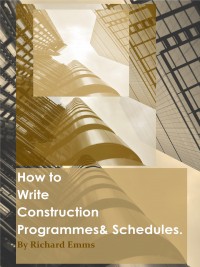My new second version How to Write Construction Programmes & Schedules not only demonstrates with Asta but includes the same steps in Microsoft Project 2013.
Although explains some basic software functions, the main message of the book is the essential preparation required before using the software. This ebook begins with a brief discussion of the documents required, then swiftly moves onto programming, sequencing, long lead items and pre-construction. With Asta Project version 12 and Microsoft Project 2013 the author demonstrates some software functions, which is similar to Microsoft Project. With a blend of commonly used computer functions, academic programming principles, and some of the writers own ideas this book delivers a practical solution to the high demands expected from today’s construction industry.
The following is the introduction of the ebook.
Not long after I graduated and employed as an assistant site manager I was asked to prepare a finishing programme for a small refurbishment project. With no industrial experience in programming and brief academic study I set out confidently to the challenge given to me. Being an ex-carpenter I thought I had a good idea how buildings are built. So I switched the PC on and immediately started dragging bars across the screen and assumed the tasks in hand. How wrong I was. The software was an early version of Microsoft Project. Typically of Microsoft, some functions were vaguely familiar and within an hour I was able to ‘fudge’ something together that made some sense. Seconds after handing my first attempt to my line manager he spotted errors with the sequence.
“You’ve got Install lights before Ceiling” He said handing the programme back to me.
It occurred to be me the most important aspect of the industry – ‘the sequence of constructing buildings’ could be taught better and after a period of muddling programmes together I needed to find a way of drafting them once and without mistakes. So I turned back to my university notes for answers. As far as I was concerned the method taught at university was correct but far too complex and would take too long in today’s industry. I needed a simple, quick, fool proof method and after much thought designed a process blending some academic principles, today’s project management software and new ideas of my own.
Of course, there are many excellent workshops that help managers operate types of software. But exactly that – operate software. Project managers and planners still need to exercise their knowledge to the software. The skill to identify tasks and decide the best time to ‘connect them to the building’, is something that computers are not able to do. That requires the skill of the individual. However, I see co-workers use software like I use to. They drag bars across the screen where they feel fit. Then they have to go over the programme again and again correcting and adjusting right up to the moment the tender is due. Many people write their programmes this way and are fine with it. However, it’s not how software are designed to be used and to fully utilise the functions provides requires a different approach. In fact, the whole method and most importantly the preparation, is crucial to the accuracy of the finished programme.
To demonstrate my method of programming I’ve used a small ‘fit out’ project that I managed in real life. This was a relatively simple project so it made sense to use an example of this type to demonstrate the principles clearly.
So this is what this book is about. How to write construction programmes. A step by step guide from the moment a tender is received through to the final document. Now, I’m not suggesting my method is correct. I’m only demonstrating a method that has proven to work for me. How I know this – is because of how ‘close’ my programmes have represent the real life construction process without the tasks becoming ‘out of sequence’.
The point of this book is to ‘funnel’ your skills and knowledge of the building process prior to using project software. By focusing on the initial preparation will make the remaining process a lot easier. I’ll be explaining a method to abstract information, a fool proof way to sequence tasks and the best practice in entering the ‘tasks’ to the software.
Now, you may want to follow my steps and plan your own project instead of following my example. This is absolutely fine, because what I’ll be explaining are principles of planning – using a real life example. So if you wish to plan your own project whilst reading this book then please do. Neverless please keep to the principles and I suggest a relatively simple project is used to begin with.
The main difference with this new edition is that I demonstrate not only with Asta Powerproject Version 12 but with Microsoft Project 2013 as well. As already mentioned the purpose of this book is to coach the reader how to draft a construction programme with the presumption that the reader is some what familiar with either Asta or Microsoft project software.
You may had already noticed that I have cropped and reduced the images. This is to maintain the quality and eligibility of the image for the reader. So please forgive me if some of the images look a little incomplete.
So firstly I would like to thank you for purchasing this book and what I’m about to share with you I know will be useful. So I kindly request you stay with me and patiently and follow the rest of the book step by step.



